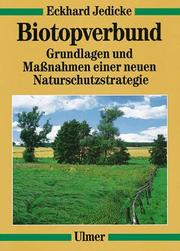| Listing 1 - 10 of 10 |
Sort by
|
Periodical
ISSN: 23443219 Year: 1999 Publisher: Sibiu, Romania : [Warsaw, Poland] : Warsaw, Poland : "Lucian Blaga" University of Sibiu, Faculty of Sciences, Department of Ecology and Environment Protection Versita De Gruyter Open
Abstract | Keywords | Export | Availability | Bookmark
 Loading...
Loading...Choose an application
- Reference Manager
- EndNote
- RefWorks (Direct export to RefWorks)
Ecology --- Periodicals. --- Natural history --- Ecology. --- Romania --- Balance of nature --- Biology --- Bionomics --- Ecological processes --- Ecological science --- Ecological sciences --- Environment --- Environmental biology --- Oecology --- History, Natural --- Natural science --- Physiophilosophy --- ecology --- biology --- biotope --- biocoenosis --- ecosystem --- biodiversity --- Environmental sciences --- Population biology --- Science
Book
ISBN: 2225830843 Year: 1998 Publisher: Paris : Masson,
Abstract | Keywords | Export | Availability | Bookmark
 Loading...
Loading...Choose an application
- Reference Manager
- EndNote
- RefWorks (Direct export to RefWorks)
Paléoécologie --- Paleoecology. --- Biocénose --- biocoenosis --- Biotope --- biotopes --- Milieu aquatique --- Aquatic environment --- Climat --- climate --- Végétation --- vegetation --- Milieu pélagique --- Pelagic environment --- Côtes --- Coasts --- Géomorphologie --- Geomorphology --- Paysage --- Landscape --- environment --- Paléoécologie --- vegetation.

ISBN: 1884015743 9781884015748 Year: 1998 Publisher: Boca Raton : St. Lucie Press,
Abstract | Keywords | Export | Availability | Bookmark
 Loading...
Loading...Choose an application
- Reference Manager
- EndNote
- RefWorks (Direct export to RefWorks)
Earthworms --- Ecology --- Congresses. --- Habitat --- Congresses --- Lumbricidae --- Taxonomie --- taxonomy --- Biogéographie --- Biogeography --- Physiologie animale --- Animal physiology --- Écologie animale --- animal ecology --- Biotope --- biotopes --- Biologie du sol --- Soil biology --- Déchet --- wastes --- Gestion des déchets --- Waste management --- Compost --- Composts --- Zoology and Animal Sciences. Biology of Animal Taxonomic Groups --- Annelida --- RBINS-OTHER --- Annelida. --- Composts. --- Lumbricina --- Lumbricus terrestris --- Ecology&delete& --- Habitat&delete& --- Haplotaxida --- Worms --- Earthworms - Ecology - Congresses --- Earthworms - Habitat - Congresses

ISBN: 3800133113 Year: 1990 Publisher: Stuttgart Verlag Eugen Ulmer
Abstract | Keywords | Export | Availability | Bookmark
 Loading...
Loading...Choose an application
- Reference Manager
- EndNote
- RefWorks (Direct export to RefWorks)
Nature conservation --- Biotic communities --- Ecosystem --- Biome --- Ecologic System --- Ecologic Systems --- Ecological System --- Habitat --- Niche, Ecological --- System, Ecological --- Systems, Ecological --- Ecosystems --- Biomes --- Ecological Niche --- Ecological Systems --- Habitats --- System, Ecologic --- Systems, Ecologic --- Ecology --- Environment --- Biocenoses --- Biocoenoses --- Biogeoecology --- Biological communities --- Biotic community ecology --- Communities, Biotic --- Community ecology, Biotic --- Ecological communities --- Natural communities --- Population biology --- Biotope network

ISBN: 2092784765 Year: 2002 Publisher: Paris : Nathan,
Abstract | Keywords | Export | Availability | Bookmark
 Loading...
Loading...Choose an application
- Reference Manager
- EndNote
- RefWorks (Direct export to RefWorks)
Forests and forestry --- Forêts et sylviculture --- Forêt tropicale --- Tropical forests --- Sous-bois --- Undergrowth --- Morphologie végétale --- Plant morphology --- Biotope --- biotopes --- Succession écologique --- ecological succession --- ECO Ecology --- adaptation --- underwood plants --- herbaceous plants --- tropical forests --- Forêts et sylviculture --- Plants --- Biodiversity --- Plant diversity --- Forest plants --- Tropical plants --- Plantes --- Biodiversité --- Diversité végétale --- Plantes des forêts --- Plantes tropicales --- Écologie des régions tropicales. --- Climat tropical. --- Adaptation --- Reproduction. --- Climatic factors. --- Reproduction . --- Effets du climat. --- Tropics --- Climate. --- Ecology.
Book
ISBN: 2738012027 9782738012029 9782759209200 2759209202 Year: 2005 Publisher: Antony : Montpellier : Paris : Cemagref ; Cirad : Ifremer ; INTA,
Abstract | Keywords | Export | Availability | Bookmark
 Loading...
Loading...Choose an application
- Reference Manager
- EndNote
- RefWorks (Direct export to RefWorks)
Urban policy --- Urban economics --- Sustainable development --- Politique urbaine --- Economie urbaine --- Développement durable --- Ville --- Towns --- Zone urbaine --- urban areas --- Parc public --- Public parks --- Jardin public --- Public gardens --- Biotope --- biotopes --- Biodiversité --- Biodiversity --- Niveau de vie --- living standards --- Urbanisation --- Urbanization --- France --- Canada --- Poland --- USA --- Développement durable --- Urban sustainable development --- Sustainable urban development --- Urban ecology (Biology) --- Urban ecology (Sociology) --- City Planning --- Urban ecology (Biology) - Urban ecology (Sociology) --- Villes --- Écologie urbaine --- Cities and towns --- 1990-.... --- Aspect de l'environnement --- Environmental aspects --- Esthetique
Book

ISBN: 287401205X 9782874012051 Year: 2007 Volume: 2 Publisher: Gembloux : Centre de recherche de la nature, des forêts et du bois (CRNFB),
Abstract | Keywords | Export | Availability | Bookmark
 Loading...
Loading...Choose an application
- Reference Manager
- EndNote
- RefWorks (Direct export to RefWorks)
Salamandres, tritons, crapauds, grenouilles, lézards et serpents composent le monde des amphibiens et reptiles de Wallonie. Plusieurs espèces sont remarquables, comme le spectaculaire escaladeur qu'est le Lézard des murailles, ou l'Alyte accoucheur dont le mâle transporte la ponte sur son dos. Au total, 21 espèces indigènes, presque toutes confrontées à une dégradation de leur situation, au point que deux amphibiens ont récemment disparu. En regard, la récente multiplication de quelques grenouilles exotiques et les nombreux lâchers de tortues aquatiques sont source d'inquiétude, compte tenu de leurs interactions potentielles avec le reste de la faune indigène. "Amphibiens et Reptiles de Wallonie " est le fruit d'un vaste travail collectif. L'ampleur de la collaboration (plus de 800 contributeurs) est en soi un signal de l'intérêt croissant porté à cette petite faune, encore souvent méconnue et parfois honnie à tort, notamment dans le cas des serpents. L'enquête de terrain a permis de rassembler plus de trente mille données et de dresser un bilan précis pour ce groupe faunique reconnu pour sa sensibilité aux agressions environnementales. L'état des connaissances, l'analyse des problèmes et des pistes pour une meilleure conservation sont détaillés dans cet ouvrage. Il dépasse donc le simple atlas de répartition des espèces au fil d'un ensemble de petites monographies qui abordent l'identification, le cycle de vie, les déplacements, le régime alimentaire, les habitats, la répartition wallonne et dans les régions alentour, les effectifs et les tendances perceptibles pour chaque espèce, y compris celles introduites dans notre environnement naturel.
Reptiles --- Amphibians --- Wallonia --- Amphibien --- amphibians --- reptiles --- Identification --- identification --- Distribution géographique --- Geographical distribution --- Écologie des populations --- population ecology --- Dynamique des populations --- population dynamics --- Biotope --- biotopes --- Organisme indigène --- Indigenous organisms --- Introduction d'animaux --- Animal introduction --- Espèce en danger --- endangered species --- Espèce protégée --- Protected species --- Belgium --- 597.6 --- 598.1 --- 591.9 <493-13> --- 502.74 --- Amphibia (Batrachia). Amphibians in general --- Reptilia. Reptiles. Herpetology --- Geographic zoology. Zoogeography. Fauna. Geographic distribution of animals--Wallonië. Waals Gewest. Région wallonne --- Protection of animal life, fauna --- 502.74 Protection of animal life, fauna --- 598.1 Reptilia. Reptiles. Herpetology --- 597.6 Amphibia (Batrachia). Amphibians in general --- Herpetology --- Wallonia (Belgium) --- identification. --- Amphibiens --- Conservation des ressources --- Amphibians. --- Reptiles. --- amphibians. --- reptiles. --- Geographical distribution. --- population ecology. --- population dynamics. --- biotopes. --- Indigenous organisms. --- Animal introduction. --- endangered species. --- Protected species. --- Belgique. --- Belgium.
Book
ISSN: 12579084 ISBN: 2738010504 9782738010506 Year: 2003 Publisher: Paris : INRA - Institut National de la Recherche Agronomique,
Abstract | Keywords | Export | Availability | Bookmark
 Loading...
Loading...Choose an application
- Reference Manager
- EndNote
- RefWorks (Direct export to RefWorks)
Agricultural landscape management --- Windbreaks, shelterbelts, etc. --- Bocages. --- Paysages agricoles --- Brise-vent --- Bocages --- Gestion --- Windbreaks, shelterbelts, etc --- Hedgerow ecology --- Land use, Rural --- Haie --- Hedges --- Agroforesterie --- agroforestry --- Faune --- Fauna --- Flore --- Flora --- Biotope --- biotopes --- Écologie animale --- animal ecology --- Phytoécologie --- plant ecology --- Paysage --- Landscape --- management --- Zone rurale --- Rural areas --- France --- Hedgerow ecology. --- 631.27 --- 630*274 --- 712.35 --- Rural land use --- Land use --- Agriculture --- Ecology --- Field borders --- Hedgerows --- Shelter belts --- Plants, Protection of --- Screens (Plants) --- Tree planting --- Windscreens --- Farmland boundary divisions. Enclosures. Hedges, hedgerows. Walls. Fences, fencing. Gates, stiles etc. Trenches. Ditches. Cattle-grids --- Hedges and hedge plants --- Tuinafscheidingen: schuttingen; hekkens; heggen --- 712.35 Tuinafscheidingen: schuttingen; hekkens; heggen --- 631.27 Farmland boundary divisions. Enclosures. Hedges, hedgerows. Walls. Fences, fencing. Gates, stiles etc. Trenches. Ditches. Cattle-grids --- Territory planning --- management.

ISBN: 041526863X 0415268648 0203647440 9780203647448 0203675495 9780203675496 9780415268639 9780415268646 9786610036950 6610036950 9781134492985 1134492987 9781134492930 1134492936 9781134492978 1134492979 1283713632 1280036958 0203688295 Year: 2004 Publisher: London : Routledge,
Abstract | Keywords | Export | Availability | Bookmark
 Loading...
Loading...Choose an application
- Reference Manager
- EndNote
- RefWorks (Direct export to RefWorks)
This book provides a key to understanding our potential environmental crisis: the concise, introductory text presents a review of current issues using a geographical approach that stresses the interrelationships between environment and societies.
Environmental degradation --- Nature --- Human ecology --- Environnement --- Homme --- Ecologie humaine --- Effect of human beings on --- Dégradation --- Influence sur la nature --- environment --- Écologie --- ecology --- Population animale --- Animal population --- Population végétale --- plant population --- Population humaine --- human population --- Biotope --- biotopes --- Impact sur l'environnement --- Environmental impact --- Évaluation --- evaluation --- Gestion des ressources --- resource management --- Urbanisation --- Urbanization --- Catastrophe naturelle --- Natural disasters --- Pollution --- Désertification --- Desertification --- world --- Environmental degradation. --- Human ecology. --- Environmental Sciences and Forestry. Ecology --- Geografie --- Effect of human beings on. --- Ecology (General) --- Landschapskunde --- Milieu en ecologie. --- 504 --- Environment. Environmental science --- Ecology (General). --- 504 Environment. Environmental science --- Dégradation --- Anthropogenic effects on nature --- Ecological footprint --- Human beings --- Anthropogenic soils --- Ecology --- Environment, Human --- Human environment --- Ecological engineering --- Human geography --- Degradation, Environmental --- Destruction, Environmental --- Deterioration, Environmental --- Environmental destruction --- Environmental deterioration --- Environmental quality --- Social aspects --- Effect of environment on --- evaluation. --- Desertification. --- Nature - Effect of human beings on. --- Nature -- Effect of human beings on. --- Nature -- Social aspects. --- Social ecology. --- Social aspects.
Book
ISBN: 9780691156989 9780691239187 0691156980 0691239185 0691254087 Year: 2022 Publisher: Princeton: Oxford: Princeton University Press,
Abstract | Keywords | Export | Availability | Bookmark
 Loading...
Loading...Choose an application
- Reference Manager
- EndNote
- RefWorks (Direct export to RefWorks)
A panoramic history of rules in the Western worldRules order almost every aspect of our lives. They set our work hours, dictate how we drive and set the table, tell us whether to offer an extended hand or cheek in greeting, and organize the rites of life, from birth through death. We may chafe under the rules we have, and yearn for ones we don't, yet no culture could do without them. In Rules, historian Lorraine Daston traces their development in the Western tradition and shows how rules have evolved from ancient to modern times. Drawing on a rich trove of examples, including legal treatises, cookbooks, military manuals, traffic regulations, and game handbooks, Daston demonstrates that while the content of rules is dazzlingly diverse, the forms that they take are surprisingly few and long-lived.Daston uncovers three enduring kinds of rules: the algorithms that calculate and measure, the laws that govern, and the models that teach. She vividly illustrates how rules can change-how supple rules stiffen, or vice versa, and how once bothersome regulations become everyday norms. Rules have been devised for almost every imaginable activity and range from meticulous regulations to the laws of nature. Daston probes beneath this variety to investigate when rules work and when they don't, and why some philosophical problems about rules are as ancient as philosophy itself while others are as modern as calculating machines.Rules offers a wide-angle view on the history of the constraints that guide us-whether we know it or not.
Authority. --- Order (Philosophy) --- Algorithms. --- Law. --- Natural law. --- Order (Philosophy). --- General ethics --- World history --- Authority --- Algorithms --- Law --- Natural law --- Computer algorithms. --- Ethics. --- Actin. --- Algorithm. --- Analogy. --- Aphorism. --- Augustine of Hippo. --- Biotope. --- Braid. --- Brain. --- Brightness. --- Calculation. --- Casuistry. --- Cataclysm (Dragonlance). --- Catechism. --- Chapter 33 (G.I. Bill of Rights). --- Charles Babbage. --- Codification (law). --- Computer program. --- Consonant. --- Culprit. --- Cydnidae. --- Cytoplasmic incompatibility. --- Depiction. --- Designer. --- Dictionary. --- Discretion. --- Drosophila. --- Early Modern literature. --- Electricity. --- Electronics. --- Epithelium. --- Fertilisation. --- Fishing. --- Francis Bacon. --- Gamma ray. --- Genre. --- Good and evil. --- Gottfried Wilhelm Leibniz. --- Government debt. --- Gut flora. --- Hannah Glasse. --- Herder. --- His Family. --- Horntail. --- Household. --- Human intelligence (intelligence gathering). --- Human intelligence. --- Imitation. --- Indication (medicine). --- Insect. --- John Herschel. --- Kinase. --- Lactobacillus. --- Lipid. --- Lookup table. --- Mathematician. --- Mathematics. --- Measurement. --- Metabolism. --- Metabolite. --- Metaphysics. --- Microbiota. --- Microorganism. --- Miguel de Cervantes. --- Monochord. --- Nationalism. --- Natural philosophy. --- Obedience (human behavior). --- Organism. --- Parallel Lives. --- Parchment. --- Pathogen. --- Philosophy. --- Phonetics. --- Polykleitos. --- Precept. --- Prerogative. --- Public utility. --- Publishing. --- Reason. --- Result. --- Rule of Saint Benedict. --- Sect. --- Shavian alphabet. --- Shawl. --- Simon Stevin. --- Spelling rule. --- State of nature. --- Statute. --- Straightedge. --- Subtitle (captioning). --- Subtraction. --- Supplication. --- The Nautical Almanac. --- The Opposite Direction. --- Titer. --- Treatise. --- Tropical rainforest. --- Usage. --- Warfare.
| Listing 1 - 10 of 10 |
Sort by
|

 Search
Search Feedback
Feedback About
About Help
Help News
News